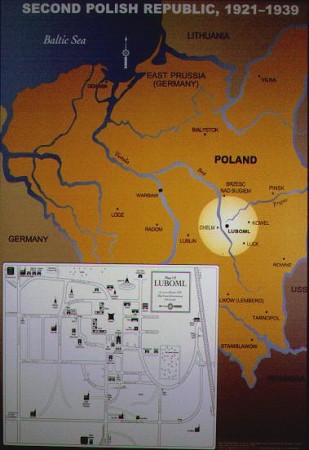|
Luboml is a
market town about 200 miles southeast of Warsaw, Poland. It is
a border town whose history dates back to the 11th century.
Along with Chelm and Belz, it was part of the Eastern
European region known as Volhynia - bordered by Lithuania on
the north, Russia to the east, and Poland to the west.
Luboml
lies in an ambiguous area of changing borders and has belonged
in succession to Russia, Poland, Lithuania, Poland, Russia and
Poland (again!). In 1939, the Germans occupied Luboml. The region was
turned over to Soviet control until 1941, when the Germans
reoccupied Luboml.
The story of Luboml is like the story of many East European Jewish
communities. In 1940, Luboml was a prosperous shtetl (market
town) with a population of more than 5,000 of whom more than
90 percent were Jewish.
The major architectural presence in Luboml was the
Great Synagogue, built in the 17th century. Above the doorway of the fortress-like four-story structure, with its Moorish
battlements, was the passage from Numbers
23.5, "How goodly
are thy tents, O Jacob." |
 |
|
Luboml was not a conspicuous place. It didn't have an
important river, and no one famous came from there.
But it was not like the quaint rural village portrayed in "Fiddler on
the Roof". Luboml was an important
regional market town with electric lights, numerous trades and
businesses, factories and workshops. Its active civic,
religious and cultural life included a theater, a cinema,
sports teams, and organizations for community welfare.
Many in the Jewish community were deeply involved in Zionist
organizations, from the far left to the far right. The
Betar movement (forerunner of the Likud Party in Israel) was
one of the dominant factions. Menachem Begin, head of Betar in
the 1930s and later Prime Minister of Israel, visited in 1934.
As anti-Semitism and the Nazi threat grew in the 1930's,
Lubomlers able to leave began to emigrate. Some went to
Palestine, others to the United States.
On October 1, 1942 the Germans, who controlled the town, with
the aid of Ukrainian police units rounded up the remaining
Jewish inhabitants of Luboml and marched them into the
countryside. There the Jews were lined up in front of open
pits and shot.
By the time
the Soviet Red Army liberated Luboml in 1945, only 51 Jews from
Luboml (excluding those who had emigrated before 1939)
survived the Holocaust. More than 1,000 died in the mass
execution on October 1, 1942. The German liquidation of the
town effectively ended a six-century history and presence of
Jewish life in Luboml.
Today Luboml is a part of the Republic of the Ukraine. But
there are no longer any Jews in the town.
Adapted from the Luboml
exhibit at the Minneapolis Jewish Community Center in 1999
|
|